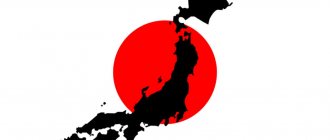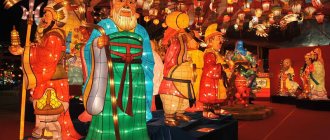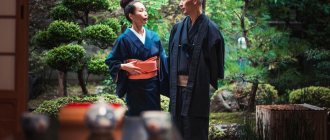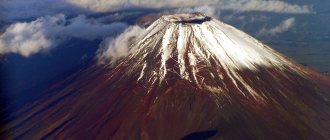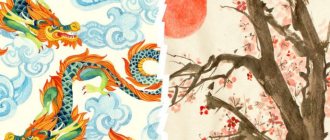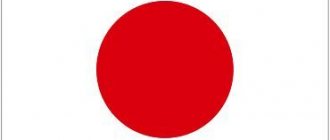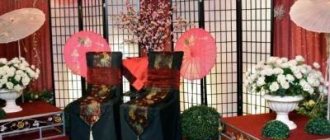The Japanese captured the "Japanese" islands, destroying the native inhabitants
Everyone knows that Americans are not the indigenous population of the United States, just like the current population of South America. Did you know that the Japanese are also not the indigenous population of Japan? Who then lived on these islands before them?...
Before them, the Ainu lived here, a mysterious people whose origins still have many mysteries. The Ainu coexisted with the Japanese for some time, until the latter managed to push them north. The fact that the Ainu are the ancient masters of the Japanese archipelago, Sakhalin and the Kuril Islands is evidenced by written sources and numerous names of geographical objects whose origin is associated with the Ainu language. And even the symbol of Japan - the great Mount Fuji - has in its name the Ainu word “fuji”, which means “deity of the hearth”. According to scientists, the Ainu settled the Japanese islands around 13,000 BC and formed the Neolithic Jomon culture there.
Settlement of the Ainu at the end of the 19th century
The Ainu did not engage in agriculture; they obtained food by hunting, gathering and fishing. They lived in small settlements, quite distant from each other. Therefore, their habitat was quite extensive: the Japanese islands, Sakhalin, Primorye, the Kuril Islands and the south of Kamchatka.
Ainu
Around the 3rd millennium BC, Mongoloid tribes arrived on the Japanese islands, who later became the ancestors of the Japanese. The new settlers brought with them the rice crop, which allowed them to feed a large population in a relatively small area. Thus began difficult times in the life of the Ainu. They were forced to move to the north, leaving their ancestral lands to the colonialists.
But the Ainu were skilled warriors, fluent with bows and swords, and the Japanese were unable to defeat them for a long time. A very long time, almost 1500 years. The Ainu knew how to wield two swords, and on their right hip they carried two daggers. One of them (cheyki-makiri) served as a knife for committing ritual suicide - hara-kiri.
The Japanese were able to defeat the Ainu only after the invention of cannons, by which time they had learned a lot from them in terms of military art. The samurai code of honor, the ability to wield two swords and the mentioned hara-kiri ritual - these seemingly characteristic attributes of Japanese culture were actually borrowed from the Ainu.
Ainu
Scientists are still arguing about the origin of the Ainu.
But the fact that this people is not related to other indigenous peoples of the Far East and Siberia is already a proven fact. A characteristic feature of their appearance is very thick hair and a beard in men, which representatives of the Mongoloid race lack. It has long been believed that they may have common roots with the peoples of Indonesia and the Pacific Aborigines, as they have similar facial features. But genetic studies ruled out this option as well.
Ainu
And the first Russian Cossacks who arrived on the island of Sakhalin even mistook the Ainu for Russians, they were so unlike the Siberian tribes, but rather resembled Europeans. The only group of people from all the analyzed variants with whom they have a genetic relationship were the people of the Jomon era, who presumably were the ancestors of the Ainu. The Ainu language is also very different from the modern linguistic picture of the world, and a suitable place has not yet been found for it. It turns out that during their long isolation the Ainu lost contact with all other peoples of the Earth, and some researchers even distinguish them into a special Ainu race.
Ainu in Russia
The Kamchatka Ainu first came into contact with Russian merchants at the end of the 17th century. Relations with the Amur and North Kuril Ainu were established in the 18th century. The Ainu considered the Russians, who were racially different from their Japanese enemies, as friends, and by the middle of the 18th century, more than one and a half thousand Ainu accepted Russian citizenship. Even the Japanese could not distinguish the Ainu from the Russians because of their external similarity (white skin and Australoid facial features, which are similar to Caucasoid ones in a number of ways). Compiled under the Russian Empress Catherine II, the “Spatial Land Description of the Russian State” included not only all the Kuril Islands, but also the island of Hokkaido into the Russian Empire.
The reason is that ethnic Japanese did not even populate it at that time. The indigenous population - the Ainu - were recorded as Russian subjects following the expedition of Antipin and Shabalin.
The Ainu fought with the Japanese not only in the south of Hokkaido, but also in the northern part of the island of Honshu. The Cossacks themselves explored and taxed the Kuril Islands back in the 17th century. So, Russia can demand Hokkaido from the Japanese.
The fact of Russian citizenship of the inhabitants of Hokkaido was noted in a letter from Alexander I to the Japanese Emperor in 1803. Moreover, this did not cause any objections from the Japanese side, much less official protest. To Tokyo, Hokkaido was a foreign territory like Korea. When the first Japanese arrived on the island in 1786, they were met by Ainu bearing Russian names and surnames. And what’s more, they are true Christians! Japan's first claims to Sakhalin date back to 1845. Then Emperor Nicholas I immediately gave a diplomatic rebuff. Only the weakening of Russia in subsequent decades led to the occupation of the southern part of Sakhalin by the Japanese.
It is interesting that in 1925 the Bolsheviks condemned the previous government, which gave Russian lands to Japan.
So in 1945, historical justice was only restored. The army and navy of the USSR resolved the Russian-Japanese territorial issue by force. Khrushchev signed the Joint Declaration of the USSR and Japan in 1956, Article 9 of which stated:
“The Union of Soviet Socialist Republics, meeting the wishes of Japan and taking into account the interests of the Japanese state, agrees to the transfer to Japan of the islands of Habomai and the island of Shikotan, however, that the actual transfer of these islands to Japan will be made after the conclusion of the Peace Treaty between the Union of Soviet Socialist Republics and Japan” .
Khrushchev's goal was the demilitarization of Japan. He was willing to sacrifice a couple of small islands in order to remove American military bases from the Soviet Far East. Now, obviously, we are no longer talking about demilitarization. Washington clung to its “unsinkable aircraft carrier” with a death grip. Moreover, Tokyo’s dependence on the United States even intensified after the accident at the Fukushima nuclear power plant. Well, if this is so, then the gratuitous transfer of the islands as a “gesture of goodwill” loses its attractiveness. It is reasonable not to follow Khrushchev’s declaration, but to put forward symmetrical claims based on known historical facts. Shaking ancient scrolls and manuscripts, which is normal practice in such matters.
An insistence on giving up Hokkaido would be a cold shower for Tokyo. It would be necessary to argue at the negotiations not about Sakhalin or even about the Kuril Islands, but about our own territory at the moment. I would have to defend myself, make excuses, prove my right. Russia would thus go from diplomatic defense to offensive. Moreover, China’s military activity, nuclear ambitions and readiness for military action by the DPRK and other security problems in the Asia-Pacific region will give another reason for Japan to sign a peace treaty with Russia.
But let's go back to the Ainu
When the Japanese first came into contact with the Russians, they called them the Red Ainu (Ainu with blond hair). Only at the beginning of the 19th century did the Japanese realize that the Russians and the Ainu were two different peoples. However, to the Russians the Ainu were "hairy", "swarthy", "dark-eyed" and "dark-haired". The first Russian researchers described the Ainu as looking like Russian peasants with dark skin or more like gypsies.
The Ainu sided with the Russians during the Russo-Japanese Wars of the 19th century. However, after defeat in the Russo-Japanese War of 1905, the Russians abandoned them to their fate. Hundreds of Ainu were killed and their families were forcibly transported to Hokkaido by the Japanese. As a result, the Russians failed to recapture the Ainu during World War II. Only a few Ainu representatives decided to stay in Russia after the war. More than 90% went to Japan.
Under the terms of the St. Petersburg Treaty of 1875, the Kuril Islands were ceded to Japan, along with the Ainu living there. 83 Northern Kuril Ainu arrived in Petropavlovsk-Kamchatsky on September 18, 1877, deciding to remain under Russian control. They refused to move to reservations on the Commander Islands, as the Russian government suggested to them. After which, from March 1881, for four months they traveled on foot to the village of Yavino, where they later settled.
Later the village of Golygino was founded. Another 9 Ainu arrived from Japan in 1884. The 1897 census indicates 57 people in Golygino (all Ainu) and 39 people in Yavino (33 Ainu and 6 Russians). Both villages were destroyed by the Soviet authorities, and the residents were resettled to Zaporozhye, Ust-Bolsheretsk region. As a result, three ethnic groups assimilated with the Kamchadals.
The Northern Kuril Ainu are currently the largest Ainu subgroup in Russia. The Nakamura family (South Kuril on the paternal side) is the smallest and has only 6 people living in Petropavlovsk-Kamchatsky. There are a few on Sakhalin who identify themselves as Ainu, but many more Ainu do not recognize themselves as such.
Most of the 888 Japanese living in Russia (2010 census) are of Ainu origin, although they do not recognize it (pure-blooded Japanese are allowed to enter Japan without a visa). The situation is similar with the Amur Ainu living in Khabarovsk. And it is believed that none of the Kamchatka Ainu are left alive.
What race are the Japanese?
The word " Japanese"
"can be used as a neutral term to designate all inhabitants of the Japanese archipelago or as an ethnonym that denotes a cultural community - the "Japanese ethnos" (without the Ryukyusans and Ainu) or a political one - the "Japanese nation" (together with the Ryukyusans and Ainu).
Origin of the Japanese
The problem of the origin of the Japanese can be considered from three positions: raceogenesis, ethnogenesis and nationogenesis.
Most Western researchers note that it is inappropriate to define the Japanese as a race or group. However, Japanese scientists note the existence of the “Japanese race” as a separate biological taxon. They associate the formation of the Japanese ethnic group and nation with it. Today, the concept of K. Hanihara, officially published by him in 1990, is generally accepted. According to it, modern Japanese are descendants of the proto-Mongoloid community of the Jomon period, close to which are the peoples of Southeast Asia. Starting from the 3rd century BC and ending with the 7th century, these proto-Mongoloids mixed with new Mongoloid migrants from the territory of Manchuria, Korea and China. As a result of the mixing, a Japanese racial type emerged, which became the basis for the formation of the Japanese ethnic group. Despite the large number of flaws in K. Hanihara’s theory, its position can be found both in scientific works and school textbooks.
If experts are ready to give a certain set of concept-answers to the question of racial genesis, then the problem of the ethnogenesis of the Japanese looks much more complicated for them. Most scientists believe that the Japanese as an ethnic group arose on the basis of the Yamato ethno-social group in the 6th-7th centuries, the basis of which was the state of Yamato in the Kinki region. However, a number of scientists argue that it is impossible to call the Yamatoans Japanese, since they were only part of the ethnic map of Japan. For these scholars, "Japanese" was a political term that united the various ethnic groups of the Japanese archipelago at the end of the Edo period in the 19th century.
From the point of view of national genesis, the Japanese arose as a nation with the advent of the nation state - Japan, in response to the aggressive actions of the nation states of Western Europe and the United States. The vested cultural communities of the Japanese islands, including the Ainu and Ryukyu, were united into a single political and social organism.
The difficulties that arise when searching for the origins of the Japanese are related to the lack of consistent and clear terminology for “race,” “ethnicity,” or “nation.” There is also no consensus among scholars about which of these terms to designate the Japanese. However, today the word “Japanese” is used mainly in a neutral sense, to refer to the inhabitants of Japan, or as a synonym for the phrase “residents of Japan”.
Japanese is the mother tongue of the vast majority of the world's Japanese and the official language of Japan. The graphic system of the language contains two alphabets (hiragana and katakana), as well as about 4 thousand borrowed Chinese characters. According to statistics from the Japanese Ministry of Education, 99% of the country's population can read and write Japanese.
The origin and classification of the language are still unclear. By the middle of the 20th century, it was believed that the Japanese language belongs to the group of Tungus-Altaic languages and is related, in particular, to Korean. However, modern researchers point to the similarity of the basic Japanese vocabulary with the vocabulary of Southeast Asian languages. The commonality of grammar with the languages of the north and the proximity of the basic vocabulary of the Japanese language from the south of the Asian continent complicates the classification procedure. Therefore, the Japanese language is usually considered isolated.
In addition to the Japanese language itself, there are Ainu and Ryukyus languages in Japan. These languages are considered by Japanese researchers as special ancient Japanese dialects, but a number of Western researchers define them as separate languages.
Culture and religion
It is believed that the basis of modern Japanese culture is the culture of the aborigines of the Japanese archipelago of the Jomon period. Integral and organic parts of Japanese culture is the versatility of traditions that are now spreading throughout the world - classical poetry, Japanese painting, tea ceremony, martial arts, bushido, architecture, samurai, the art of constructing ornamental gardens, flower arranging (ikebana), assembling figures ( origami), traditional noo opera, bunraku puppet theater, city kabuki theater, Japanese cuisine.
Oddly enough, it may seem that the formation of Japanese culture is a constant borrowing and “digestion” of foreign ideas. Traditionally, the main importers of world achievements were Korea, China, Spain, Portugal, and Holland. Since the mid-19th century, the countries of Western Europe and the USA have acted as an “intellectual donor”. Know-how adapted to Japanese soil became the basis for the development of unique Japanese products and creations. Today, Japanese electronics, manga and anime are famous among them.
Religion plays an important role in the life of the Japanese. However, its functioning is different from that in the West. Combination is characteristic, that is, simultaneous belonging to two or more religious movements. The main religions in Japan are Shinto and Buddhism. About 1% of the population professes Christianity.
Ethnic groups
Japanese (Yamatois, Ryukuis, Ainu) - about 99%. The rest (Chinese, Koreans, Brazilians, Filipinos, others) - about 1%.
During the period of the Japanese Empire (1867 - 1945), Koreans and Taiwanese were considered “political” Japanese. Some of the Nivkhs who lived on Sakhalin also had Japanese citizenship. After the occupation of Sakhalin by the USSR, they were expelled to Hokkaido as “Japanese”.
According to the Ministry of Foreign Affairs, the number of Japanese living abroad is about 1 million. Most of them live in the USA. They are followed by Japanese communities in China, Brazil and Great Britain.
The term Nikkei (日系 - "Japanese") usually refers to people who are of Japanese descent, whose ancestors immigrated from Japan and live abroad.
The etymology of the name is close to the Russian word “Russian”. The latter is someone who belongs to “Rus”, but is not a “Russian”. A similar thing is observed in the name Nikei - a person has a close connection with Japan, but he is not actually “Japanese”. In general, the Nikei term refers to the entire Japanese diaspora. The Japanese diaspora has a 140-year history. The first Japanese emigrants began moving to Hawaii in 1868. About 750,000 people migrated abroad before the Second World War. Another 250,000 moved abroad in the second half of the 20th century.
Japanese emigrants and their descendants maintain a sense of community and maintain ties to the country of their ancestors. They play an important role in the societies that have adopted them. As an example, we can cite the reign of Peruvian President Alberto Fujimori (1990-2000), who came from a family of Japanese immigrants.
Epilogue
In 1979, the USSR deleted the ethnonym “Ainu” from the list of “living” ethnic groups in Russia, thereby declaring that this people had become extinct on the territory of the USSR. Judging by the 2002 census, no one entered the ethnonym “Ainu” in fields 7 or 9.2 of the K-1 census form. There is information that the Ainu have the most direct genetic connections through the male line, oddly enough, with the Tibetans - half of them are carriers of the close haplogroup D1 (the D2 group itself is practically not found outside the Japanese archipelago) and the Miao-Yao peoples in southern China and in Indochina.
As for female (Mt-DNA) haplogroups, the Ainu group is dominated by group U, which is also found among other peoples of East Asia, but in small numbers. During the 2010 census, about 100 people tried to register themselves as Ainu, but the government of the Kamchatka Territory rejected their claims and recorded them as Kamchadals.
In 2011, the head of the Ainu community of Kamchatka, Alexey Vladimirovich Nakamura, sent a letter to the Governor of Kamchatka Vladimir Ilyukhin and the Chairman of the local Duma Boris Nevzorov with a request to include the Ainu in the List of Indigenous Peoples of the North, Siberia and the Far East of the Russian Federation. The request was also rejected. Alexey Nakamura reports that in 2012 there were 205 Ainu registered in Russia (compared to 12 people registered in 2008), and they, like the Kuril Kamchadals, are fighting for official recognition. The Ainu language became extinct many decades ago.
In 1979, only three people on Sakhalin could speak Ainu fluently, and the language became completely extinct there by the 1980s. Although Keizo Nakamura spoke Sakhalin-Ainu fluently and even translated several documents into Russian for the NKVD, he did not pass on the language to his son. Take Asai, the last person who knew the Sakhalin Ainu language, died in Japan in 1994.
Until the Ainu are recognized, they are noted as people without nationality, like ethnic Russians or Kamchadals. Therefore, in 2016, both the Kuril Ainu and the Kuril Kamchadals were deprived of the rights to hunting and fishing, which the small peoples of the Far North have.
Where to meet the Ainu?
Since the Ainu people are considered assimilated in Japan, it is fair to say that it is not easy to communicate with purebred Ainu in this country. The rigorous teaching of the Japanese language, customs and beliefs, as well as intermarriages with the invaders, meant that once they came under the complete control of the new Japanese, the Ainu lost the opportunity to express their originality. After fifteen centuries of harsh confrontation, in the 19th century the beards of this people were shaved off, ancient rituals were prohibited, as were tattoos on women’s faces and national Ainu costumes. Only a few black and white photographs remain in ethnographic museums as a reminder of this nation disappearing from the face of the Earth.
It is still possible to meet the Ainu, because it is believed that at least 25 thousand of them live in Japan. However, before you go to Hokkaido, go to the Tokyo National Museum to get acquainted with the Jomon culture. It is widely represented here through ceramic products with a characteristic rope ornament. The age of some ceramic samples is comparable to the age of some Egyptian pyramids. The most ancient ancestors of the modern Ainu made their clay vessels and tools already in the 4th century BC.
